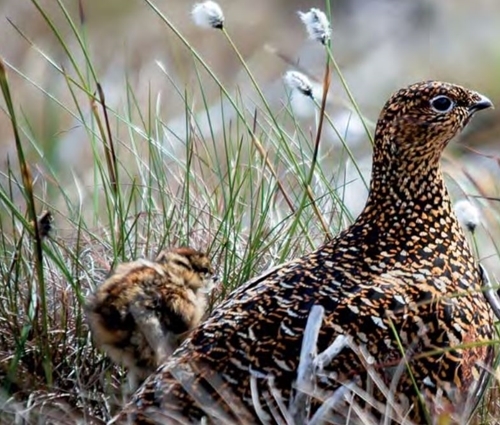Written by Dave Baines, Director of Upland Research
4 Minute Read

In the summer issue of Gamewise (written in early May), I predicted that this year was likely to be a difficult one for red grouse across the moors of northern England. The likely causative agents were poor quality heather as food, a paucity of protein-rich cotton grass flowers in early spring and unebbing levels of intestinal strongyle worm parasites. Writing this on 3 August, with the last grouse count completed only yesterday, I have reviewed our season’s data to consider whether our prediction came true.
In essence, yes, it most certainly did. For many, this year will go down as the worst since the last big strongyle-induced grouse population crash in 2005. So, what has gone so badly wrong? Put simply, grouse were in poor condition in spring. The factors underlying bird condition probably subtly varied between moors, but the principal cause was likely to be low food quality. In turn, poor heather food was attributable to widespread heather damage and resultant die-back following recent heather beetle attacks. Here, our research has shown that both lower grouse densities and breeding success occurred where damage by heather beetle was greatest. Further heather browning during the winter, severe frosts in May and delayed heather greening which didn’t happen until June have added to the problem. Furthermore, cotton grass flower abundance, vital for good clutch production among hens, was three-quarters down on the previous spring, while on many moors high parasitic worm burdens appeared not to have been alleviated by the provision of flubendazole-based (medicated) grit. In effect, the balance of the grouse health equation between the positive effect of good food quality and the negative one of parasite intensity had tipped towards the parasite.
Poor maternal condition was soon translated into low clutch sizes, with an average of only 6.3 eggs, compared with 8.5 in 2020. Even more astonishing were observations of colleagues working in Bowland that some radio-tagged hen grouse appeared not to breed at all, something strongly suspected by gamekeepers on some high-altitude Pennine moors.
The next problem became apparent at chick hatch. Although hatch rates appeared reasonable, the already fewer chicks due to fewer eggs laid, soon experienced high mortality associated with a seasonal mismatch in the emergence of craneflies, their key insect food. This year we started a study of cranefly emergence and flight periods using yellow sticky fly papers on two Teesdale moors. These showed a peak insect emergence in the first week of June, an estimated two weeks after the main grouse hatch. It was evident that the cold weather had delayed cranefly emergence more than it had delayed grouse breeding. Facing an insect shortage and browned heather, chick mortality was generally high, especially so on higher-altitude peatland moors.
The eventual cranefly emergence and greening of the heather only came after most chicks had died, leading to low grouse productivity on our July counts. This problem of few chicks has been exacerbated by apparently high mortality of adults between successive spring and July counts. While counting grouse, we found relatively high incidences of weakened birds struggling to fly, the typical symptoms of strongylosis. High worm counts conducted from sample birds confirmed this diagnosis. Small clutches, low chick survival and, in some cases, high adult mortality largely explain the lowest set of grouse counts since 2005 and prospects for the shooting season are very bleak indeed with most grouse managers having already cancelled shooting.
The described situation leaves grouse moor managers in a dilemma and with key questions that need to be addressed.
- How can heather be successfully restored following beetle attacks?
- Can heather management be fine-tuned to mitigate against the likelihood of future outbreaks, the frequency of which may increase?
- Why didn’t medicated grit deliver the expected reductions in strongyle worm burdens?
- Will climatic extremes of drought, downpours and ice become more commonplace making not only red grouse production less predictable, but also the very persistence of rarer species like black grouse and grey partridge less likely in the English uplands? They fared poorly too.
Maybe this was just a bad year, quite like the previous one. Alternatively, a changing climate, together with its associated extremes, may herald conditions that favour grouse parasite and heather pathogens, and render insect emergence less predictable. Perhaps the golden years of grouse are over.